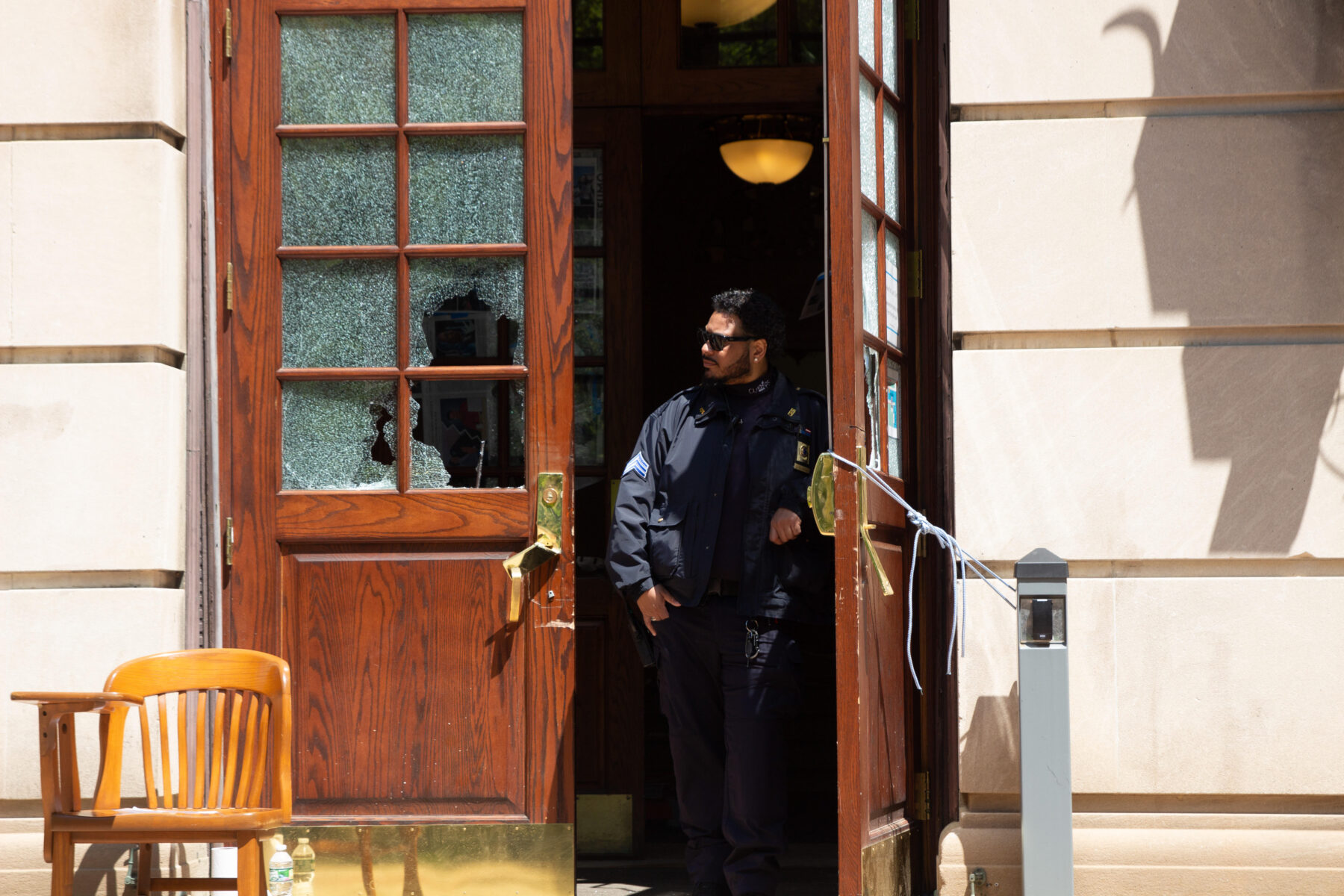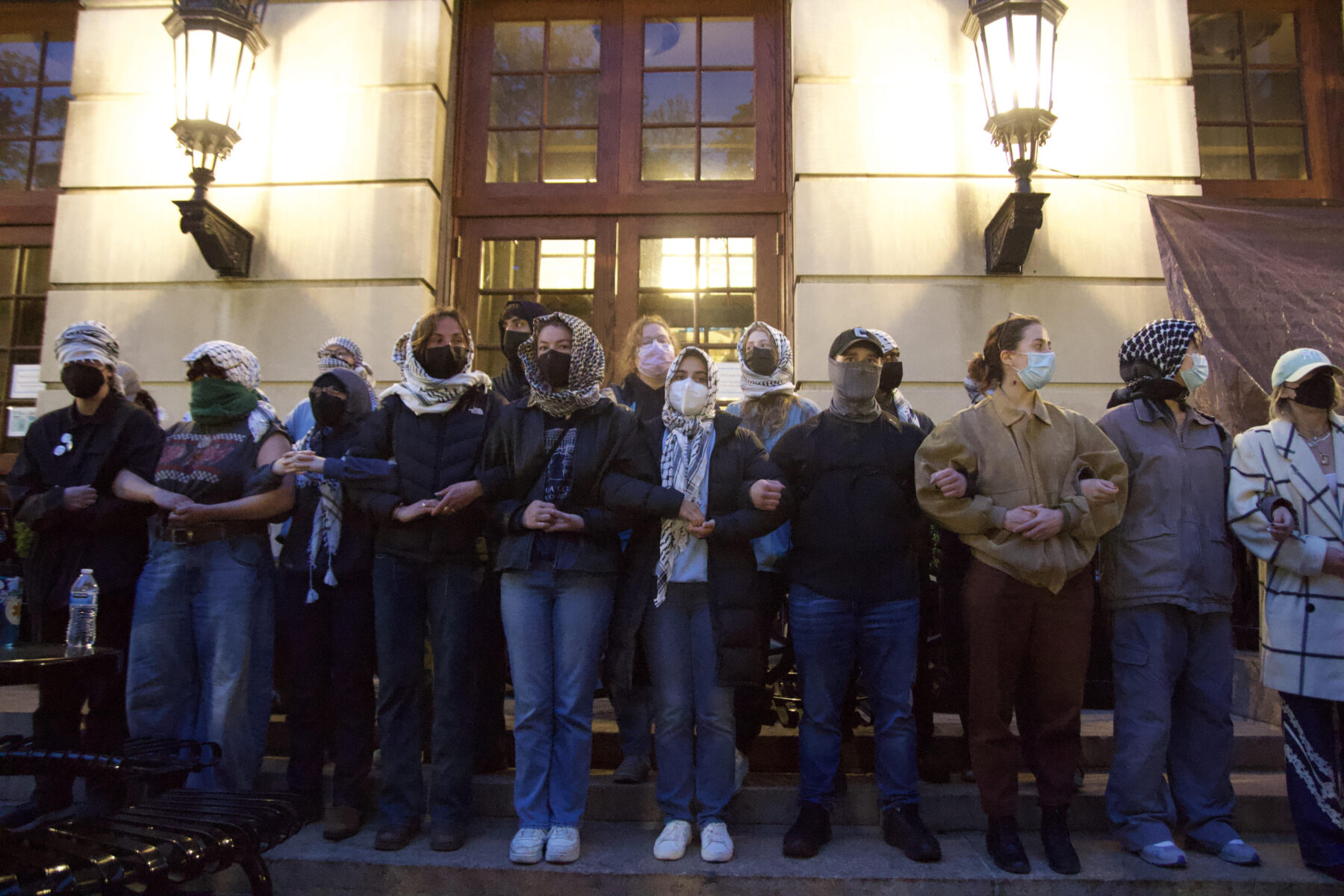
A public safety officer stands in the doorway of Hamilton Hall on May 1, 2024, a day after police raided the protests at Columbia University. (Credit: Indy Scholtens)
Days after the arrest of protesters that occupied Columbia University’s Hamilton Hall, the presence of “outsiders” inside the building continues to be up for debate. Law enforcement and university officials have released a breakdown of the arrests, tagging 13 of the 44 individuals in the hall as “non-affiliates.” But protesters say these demonstrators are alumni and chapter members of other social justice organizations.
Ben Chang, Vice President of Communications, released the university’s findings during a press conference on May 2, which are based on an analysis of the April 30 arrests completed by the New York City Police Department (NYPD).
Chang said the number of “non-affiliates,” or people who aren’t students, employees, or volunteers, for example, reflect the University’s expectations that “a significant portion of those who broke the law and occupied Hamilton Hall were outsiders.” The students who occupied the Hamilton Hall are currently charged with burglary, trespassing, or criminal mischief.
However, student protesters who were among those arrested in Hamilton Hall said the non-affiliates being described by officials were alumni of Columbia University.
IAM, 25, a student and co-organizer of the Gaza Solidarity Encampment, who was arrested by the NYPD on April 30 said most of the people inside the building were, “active students, and the non-affiliates they describe are alumni.”
He added, “The narrative of outsiders was an obvious ploy to manufacture consent for the state violence that happened.”
Of the 44 people arrested for demonstrations related to the Hamilton Hall occupation, more than half were undergraduates, graduate students, and employees of Columbia University, while six were students at affiliated institutions like Barnard or Teachers College.
“CCNY, FIT, Fordham, NYU—all of them also had their own encampments for Gaza and students have been traveling to each other’s campuses to show solidarity,” according to JG, who requested anonymity to prevent retaliation from the school administration, a 25-year-old undergraduate student at General Studies in Columbia University who was among those protesting.
Some of the people arrested during the police sweep of Columbia University on April 30 were members of social justice organizations from different chapters in New York including Within Our Lifetime, Jewish Voice for Peace, Students for Justice in Palestine, and other social justice organizations.
Mayor Eric Adams also expressed concerns of about “outside individuals that have been “influencing the issue” after students took over Hamilton Hall.
But protesters said this “outsider” narrative takes focus away from the death toll in Gaza and their demands for Columbia’s complete divestment from the region.
“They were not taking over the building to be physically destructive. There was a purpose for it. They were doing it in the tradition of the 1968 protest against Vietnam. It was very intentional – everything about it was intentional,” said JG.
A graduate student at Columbia's School of International and Public Affairs, who was arrested for protesting and has requested anonymity to prevent retaliation from the school, said that the majority of protesters were affiliated with the university, but others were organizational partners from other chapters of Students for Justice in Palestine.
SA, a 19-year-old Columbia College student who also requested anonymity to avoid disciplinary action from the school, agreed. SA was barricading the Hall from the outside.
“I was nervous about the cops coming and shutting us down. Constant fear that we will be subjected to police brutality,” SA said. However they reiterated that people inside were aware about the potential risks and that, inside Hamilton, “there were student protestors who agreed to risk arrest in case the situation escalated.”

Protesters lock arms in front of Hamilton Hall on April 30, moments before the police sweep in at Columbia University.
(Credit: Indy Scholtens)
During a joint press conference of City College New York and Columbia University on May 1, Maryam Alwan, a student organizer, expressed extreme frustration.
“Columbia and the cops collaborated to brutalize my classmates in the dark for standing up for what is right. The mainstream media is currently lying about outside detractors and overblowing property damage in order to justify brutality and distract from their complicity in genocide. Just as they did in [the] civil rights movement, Black Lives Matter, and every other social movement for change,” Alwan said to a crowd including media, students, and protestors at CCNY.
“To be clear the police caused far more property damage and physical endangerment than my classmates ever did.” Alwan was one of the students that Columbia was suspended for participating in Gaza Solidarity Encampment on April 18.
Why does the distinction between “affiliates” of the university, and “non-affiliates,” matter?
“In my mind it does not matter,” said Helen Benedict, a journalism professor at Columbia University and a journalist who covers social justice. (Benedict also taught the authors of this story.)
Benedict said the phrase of outside-agitators is inaccurate and characterizes students as “hapless pawns getting pushed around and it takes away from the autonomy and decision-making that intelligent, well-informed young people are making.”
“I have been told that students have consulted people who practice de-escalation about how to run an orderly protest, how to organize themselves, how to stay safe, how to run a camp, so these are people who have the students’ best interests in mind and they are acting as more mature advisors.” But the problem with the phrase “outside-agitators,” Benedict added, is that it “suggests crazy, dangerous, radical types who are whipping up students to do dangerous illegal things.”
Benedict has been struck by how the student-run encampment was so organized and peaceful with its own library and teach-ins and everyone looking after each other.
She added that the same rhetoric of outsiders was used all the time in the 60s and early 70s when students protested against the Vietnam war in 1968.
The Gaza Solidarity Encampment are demanding financial transparency, complete divestment from companies that do business with the Israeli government, and amnesty for protesting students. Once negotiations deteriorated, the organizers of the encampment escalated their activism and occupied Hamilton Hall for 21 hours before law enforcement stormed in. The organizers renamed the building Hind’s Hall, after the six-year-old Palestinian girl Hind Rajab who was killed in the ongoing war in Gaza.
A total of 109 protesters inside and outside Hamilton Hall were arrested by the NYPD on April 30.
“The occupiers violated various University policies, but more importantly, they broke the law. Actions have consequences,” Chang, the university spokesperson, said on May 2.
About the author(s)
Subeksha Poudel is a freelance journalist who covers social justice, aging, and climate change in New York.
Katrina Ventura is a data journalist based in New York who covers politics, justice, and online disinformation.



